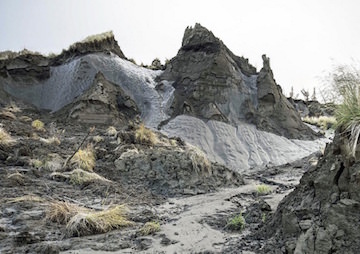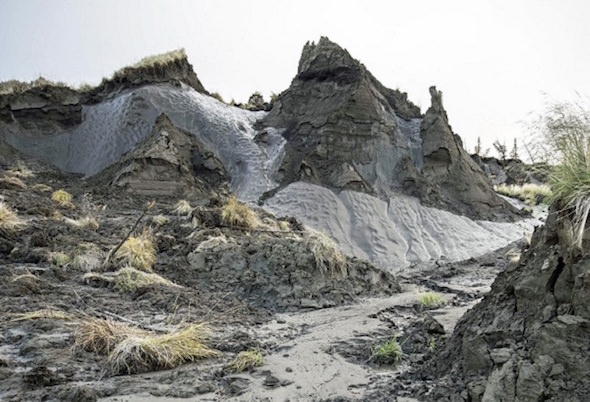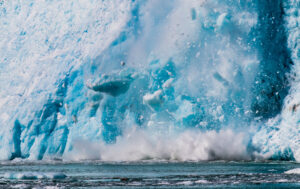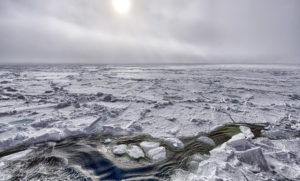Permafrost Thaw Would Have Runaway Effect on Carbon Release
Arctic warming is causing organic carbon that has been frozen deep in the soil for millennia to be released rapidly into the air as CO2, with potentially catastrophic impacts on the climate.
By Tim Radford, Climate News Network

A bank of thawing permafrost near the Kolyma River in Siberia. (Skidaway Institute of Oceanography)
This Creative Commons-licensed piece first appeared at Climate News Network.
LONDON — An international team of scientists has settled one puzzle of the Arctic permafrost and confirmed one long-standing fear: the vast amounts of carbon now preserved in the frozen soils could one day all get back into the atmosphere.
Since the Arctic is the fastest-warming place on the planet, such a release of greenhouse gas could only accelerate global warming and precipitate catastrophic climate change.
That the circumpolar regions of the northern hemisphere hold vast amounts of deep-frozen carbon is not in question.
The latest estimate is 17 billion tonnes, which is twice the level of carbon dioxide in the atmosphere and perhaps 10 times the quantity put into the atmosphere by burning fossil fuels since the start of the Industrial Revolution.
Hazard underlined
In recent weeks, researchers have already underlined the potential hazard. But the big question has been that if some of the trapped carbon must be escaping now, where is it going?
Researchers have checked the mouths of the Arctic rivers for the telltale evidence of ancient dissolved organic carbon — partly-rotted vegetable matter deep-frozen more than 20,000 years ago — and found surprisingly little.
Now Robert Spencer, an oceanographer at Florida State University, and colleagues from the US, UK, Russia, Switzerland and Germany report in Geophysical Research Letters that the answer lies in the soil — and in the headwater streams of the terrestrial Arctic regions.
Instead of flowing down towards the sea, the thawing peat and ancient leaf litter of the warming permafrost is being metabolised by microbes and released swiftly into the atmosphere as carbon dioxide.
“We found that decomposition converted 60% of the carbon
in the thawed permafrost to carbon dioxide in two weeks”
The scientists conclude that the microbes, once they get a chance to work at all, act so fast that half of all the soil carbon they can get at is turned into carbon dioxide within a week. It gets into the atmosphere before it has much chance to flow downstream with the soil meltwater.
The researchers centred their study on Duvanny Yar in Siberia, where the Kolyma River sluices through a bank of permafrost to expose the frozen organic carbon.
They worked at 19 different sites — including places where the permafrost was more than 30 metres deep — and they found tributary streams made entirely of thawed permafrost.
Measurement of the carbon concentration confirmed that it was indeed ancient. The researchers analysed its form in the meltwater, then they bottled it with a selection of local microbes, and waited.
Used by microbes
“We found that decomposition converted 60% of the carbon in the thawed permafrost to carbon dioxide in two weeks,” says Aron Stubbins, assistant professor at the University of Georgia’s Skidaway Institute of Oceanography. “This shows that permafrost carbon is definitely in a form that can be used by the microbes.”
The finding raises a new — and not yet considered — aspect of the carbon cycle jigsaw puzzle, because what happens to atmospheric and soil carbon is a huge element in all climate simulations.
At he moment, permafrost carbon is not a big factor in projections by the Intergovernmental Panel on Climate Change.
Dr Spencer says: “When you have a huge frozen store of carbon and it’s thawing, we have some big questions. The primary question is, when it thaws, what happens to it?
“Our research shows that this ancient carbon is rapidly utilised by microbes and transferred to the atmosphere, leading to further warming in the region, and therefore more thawing. So we get into a runaway effect.”
Your support is crucial…With an uncertain future and a new administration casting doubt on press freedoms, the danger is clear: The truth is at risk.
Now is the time to give. Your tax-deductible support allows us to dig deeper, delivering fearless investigative reporting and analysis that exposes what’s really happening — without compromise.
Stand with our courageous journalists. Donate today to protect a free press, uphold democracy and unearth untold stories.









You need to be a supporter to comment.
There are currently no responses to this article.
Be the first to respond.